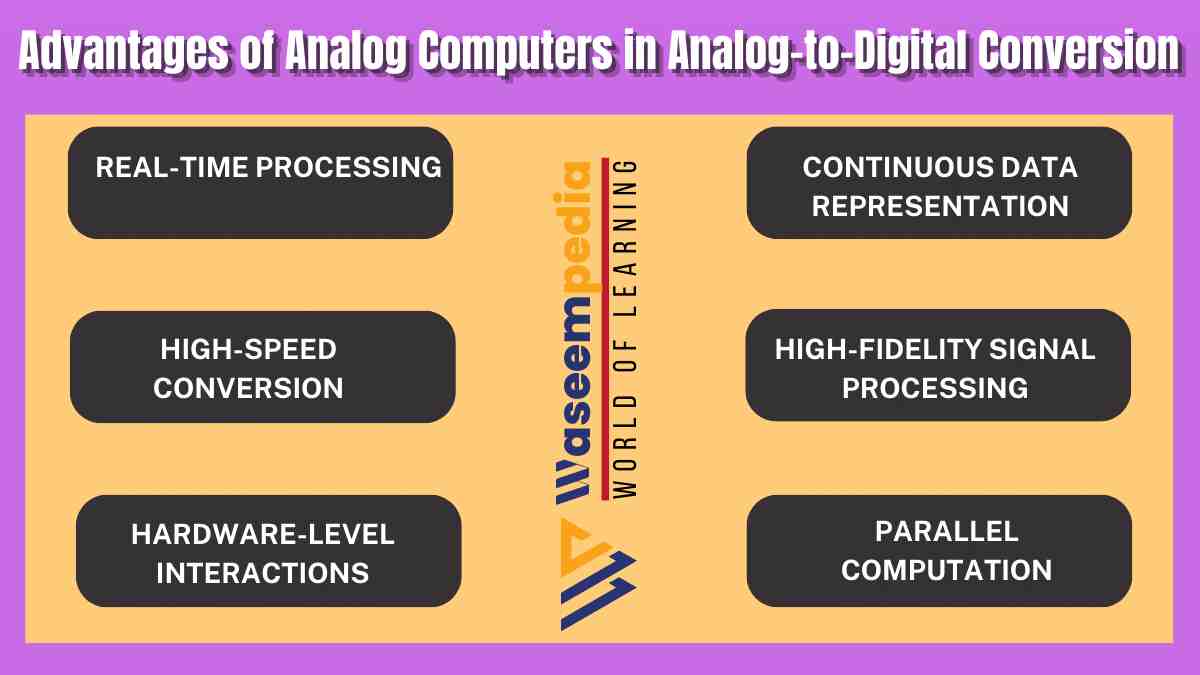Analog computers offer significant advantages in analog-to-digital conversion, including real-time processing, continuous data representation, high-speed conversion, high-fidelity signal processing, hardware-level interactions, and parallel computation.
While digital computers and microcontrollers are commonly used for analog-to-digital conversion, analog computers provide unique benefits in handling continuous analog signals and achieving high-speed, high-fidelity conversion. The combination of analog and digital approaches can contribute to more accurate and efficient analog-to-digital conversion in various applications.
Analog-to-digital conversion is a crucial process in modern technology that involves converting analog signals into digital form for processing, storage, and analysis. While digital computers and microcontrollers are commonly used for this task, analog computers offer unique advantages that make them valuable tools in analog-to-digital conversion.
In this article, we will explore the advantages of analog computers in analog-to-digital conversion and understand their significance in this domain.
Analog-to-digital conversion is essential for capturing and processing analog signals in digital systems. It involves measuring the continuous analog signal and representing it as a discrete digital value. While digital computers and microcontrollers are widely used for analog-to-digital conversion, analog computers provide unique benefits that can enhance the conversion process.
By leveraging the continuous nature of analog computation, analog computers offer advantages in real-time processing, continuous data representation, and high-speed, high-fidelity signal processing.
What is Analog Computers?
Analog computers process information using continuous physical quantities, such as voltages or currents, to represent and manipulate data. Unlike digital computers that operate on discrete values, analog computers can directly model and simulate the behavior of analog signals.
In the context of analog-to-digital conversion, analog computers offer an alternative approach to understanding and processing analog signals.
6 Advantages of Analog Computers in Analog-to-Digital Conversion
6 Advantages of Analog Computers in Analog-to-Digital Conversion are as given below
1. Real-Time Processing
Real-time processing is crucial in analog-to-digital conversion, especially when dealing with time-sensitive signals or real-time monitoring. Analog computers excel in real-time processing due to their ability to work with continuous data streams without the need for digitization or discretization.
This real-time capability allows analog computers to measure and process analog signals in real-time, enabling timely conversion and analysis.
2. Continuous Data Representation
Analog computers utilize continuous data representation, which is advantageous in analog-to-digital conversion. Analog signals are continuous in nature, and analog computers can process and represent this continuous data without the loss of information associated with digitization.
By working with continuous data, analog computers can provide a more accurate representation of the analog signal, ensuring that the digital conversion retains the fidelity and details of the original signal.
3. High-Speed Conversion
Analog computers offer high-speed conversion capabilities, making them suitable for applications that require rapid analog-to-digital conversion. The continuous nature of analog computation allows for efficient and parallel processing of multiple data points simultaneously.
Analog computers can handle high sampling rates and convert analog signals into digital form at high speeds, ensuring real-time conversion and processing of time-critical signals.
4. High-Fidelity Signal Processing
Analog computers excel in high-fidelity signal processing, which is essential in preserving the quality and accuracy of the analog-to-digital conversion. Analog computers can perform precise filtering, amplification, and signal conditioning operations, ensuring that the digital representation of the analog signal maintains its integrity.
The high-fidelity signal processing capabilities of analog computers contribute to accurate and reliable analog-to-digital conversion.
5. Hardware-Level Interactions
Analog computers enable hardware-level interactions in analog-to-digital conversion. They can directly interface with physical sensors, detectors, and measurement devices to capture and process analog signals.
This hardware-level interaction enhances the accuracy and timeliness of analog-to-digital conversion, as analog computers can evaluate the behavior of physical components and assess data in real-time with direct connections.
6. Parallel Computation
Analog computers are inherently parallel computing machines, capable of performing multiple computations simultaneously. This parallel processing capability is advantageous in analog-to-digital conversion, where multiple data points need to be processed concurrently.
Analog computers can efficiently handle the parallel nature of analog signals and perform high-speed, parallel computations to convert multiple analog signals into digital form simultaneously.

